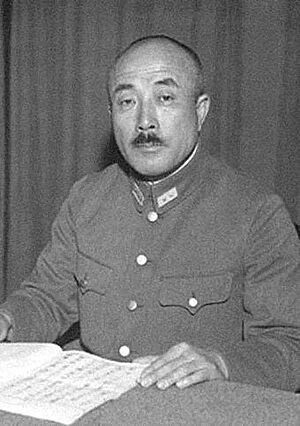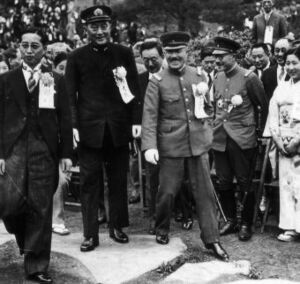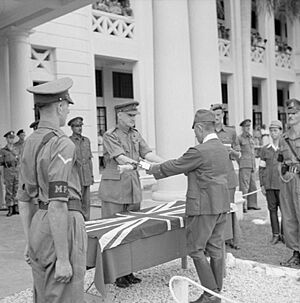Seishirō Itagaki facts for kids
Quick facts for kids
Seishirō Itagaki
|
|
|---|---|
|
板垣征四郎
|
|

Itagaki in 1938
|
|
| Minister of War of the Japanese Empire | |
| In office 3 June 1938 – 30 August 1939 |
|
| Monarch | Shōwa |
| Prime Minister |
|
| Preceded by | Hajime Sugiyama |
| Succeeded by | Shunroku Hata |
| Personal details | |
| Born | 21 January 1885 Morioka, Iwate, Japan |
| Died | 23 December 1948 (aged 63) Sugamo Prison, Tokyo, Occupied Japan |
| Cause of death | Execution by hanging |
| Alma mater | Imperial Japanese Army Academy |
| Profession | Military |
| Military service | |
| Allegiance | |
| Branch/service | |
| Years of service | 1904–1945 |
| Rank | |
| Commands |
|
| Battles/wars | Russo-Japanese War
Japanese invasion of Manchuria Pacification of Manchukuo Second Sino-Japanese War
|
General Seishirō Itagaki (板垣 征四郎, Itagaki Seishirō, 21 January 1885 – 23 December 1948) was a Japanese military officer and politician. He became a general in the Imperial Japanese Army during World War II. He also served as the War Minister for Japan from 1938 to 1939.
Itagaki played a key role in planning the Mukden Incident. This event led to Japan taking control of Manchuria. He held important leadership positions in the Kwantung Army and the China Expeditionary Army. This was during the early part of the Second Sino–Japanese War. After being War Minister, his career faced challenges following a Japanese defeat against the Soviet Union. He continued to serve as a general until Japan surrendered in Southeast Asia in 1945. Later, Itagaki was found guilty of war crimes and was executed in 1948.
Contents
Early Life and Education
Seishirō Itagaki was born on January 21, 1885. His birthplace was Morioka in Iwate Prefecture, Japan. His family had a history as samurai warriors. They had served the Nanbu clan in the Morioka area.
Itagaki's father, Masanori Itagaki, was a local leader. He worked as a mayor and also as a school headmaster. Seishirō went to junior high school in Morioka. After that, he attended a regional military school in Sendai.
Military Career Highlights
Itagaki joined the Imperial Japanese Army Academy. Here, he met many future military leaders. He graduated from the Academy in 1904. Soon after, he fought in the Russo–Japanese War. He later married Kikuko Ogoshi. Her father was Kenkichi Ogoshi, who had been Itagaki's mentor.
Early Assignments in China
From 1924 to 1926, Itagaki worked at the Japanese embassy in China. He was a military attaché, which means he helped with military relations. When he returned to Japan, he held several staff jobs. In 1927, he was given command of the IJA 33rd Infantry Brigade in China.

From 1928 to 1929, Itagaki commanded the IJA 33rd Infantry Regiment in China. This unit was part of the important Kwantung Army. In 1931, he became the Chief of the Intelligence Section for the Kwantung Army. In this role, he helped plan the 1931 Mukden Incident. This event led to Japan taking over Manchuria.
Role in Manchukuo and Kwantung Army
After the Mukden Incident, Itagaki became a military advisor. He worked for the Japanese-controlled state of Manchukuo from 1932 to 1934. In 1934, he became the Vice Chief of Staff of the Kwantung Army. By 1936, he was promoted to Chief of Staff.
Second Sino-Japanese War
From 1937 to 1938, Itagaki led the IJA 5th Division in China. This was during the early parts of the Second Sino–Japanese War. His division played a major part in several battles. These included the Battle of Beiping–Tianjin, Operation Chahar, and the Battle of Taiyuan. However, his forces faced difficulties during the Battle of Taierzhuang. This prevented them from helping other Japanese units.
War Minister and Later Commands
Itagaki returned to Japan in 1938. He served as the War Minister from 1938 to 1939. During this time, he supported a national policy called Hakko Ichiu. This policy aimed for expansion. On December 6, 1938, a high-level meeting decided to prevent the expulsion of Jews from Japan, Manchuria, and China. This became a Japanese national policy.
Itagaki went back to China in 1939. He became the chief of staff for the China Expeditionary Army. However, a major defeat for Japan against the Soviet Union in 1939 affected his career. This was the Battle of Khalkhin Gol, also known as the Nomonhan incident.
On July 7, 1941, Itagaki was moved to command the Chosen Army in Korea. This was considered a less important position. As World War II continued, Japan's situation worsened. The Chosen Army was renamed the Japanese Seventeenth Area Army in 1945. Itagaki remained its commander in chief until April 7, 1945. He was then sent to lead the Japanese Seventh Area Army in Singapore and Malaya. Itagaki officially surrendered Japanese forces in Southeast Asia to British Admiral Louis Mountbatten in Singapore on September 12, 1945.
Post-War and Conviction
After World War II ended, Itagaki was taken into custody. He was charged with war crimes by the Supreme Commander of the Allied Powers. The charges included his role in Japan's takeover of Manchuria. He was also accused of increasing the war against the Allies while he was War Minister. Another charge was allowing cruel treatment of prisoners of war when he commanded forces in Southeast Asia.
Itagaki was found guilty of several charges. He was sentenced to death in 1948 by the International Military Tribunal for the Far East. Seishirō Itagaki was executed on December 23, 1948, at Sugamo Prison in Tokyo.
Images for kids



